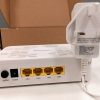Which Suggest UK ISPs May Get Average Broadband Speeds Wrong
Next week a change in UK advertising guidelines will mean that broadband ISPs need to start promoting “average download speeds” (a MEDIAN measured at peak time 8-10pm) on their public packages (details). But a new study by Which? suggests that some may end up over estimating their averages.
The consumer magazine claims to have conducted 235,000 speedtests via their own checker tool (between 1st May 2017 to 30th April 2018), which then appear to have been filtered in order to identify which product was being tested. On top of that they also filtered out any results from mobile and “exclusively” business providers (the latter suggests they couldn’t filter out all business connections that are domestic grade).
In terms of the results, Which? found that customers of so-called ‘up to’ 17Mbps (ADSL2+) standard broadband packages only received a median average download of just 6Mbps (33% of the currently advertised rate), while ‘up to’ 38Mbps (FTTC / VDSL2) services typically delivered an average of 22Mbps (57% of the current rate) and even Virgin Media’s 200Mbps tier only produced 52Mbps (26% of the current rate).
Advertisement

The results are interesting, particularly because a couple of ISPs have already adopted the Advertising Standards Authority’s (ASA) new rules and so we can do a simple comparison. For example, Sky Broadband and the Post Office have both converted their ‘up to 17Mbps’ service to promote an average of 11Mbps (vs the 6Mbps above) and their ‘up to 38Mbps’ tier is now an average of 34Mbps and 35Mbps respectively (vs the 22Mbps above).
Alex Neill, Which? MD of Home Services, said:
“This change in the rules is good news for customers who have been continuously been let down by unrealistic adverts and broadband speeds that won’t ever live up to expectations.
We know that speed and reliability of service really matter to customers and we will be keeping a close eye on providers to make sure they follow these new rules and finally deliver the service that people pay for.”
Overall Which? claims that British households are paying for broadband services that are on average 51% slower than CURRENTLY advertised (existing rules allow ISPs to show a speed from the fastest 10% of users on a package). Of course this is Which? and that means there are potentially some very crucial caveats to their data, which aren’t stated in the press release and so we assume they haven’t been considered.
Perhaps the biggest problem here is that consumer speedtest based data, particularly when clumped together from lots of users without significantly deeper filtering, is inherently unreliable as a comparison of package performance.
The reason for that is because the results can be influenced by all sorts of different factors, such as slow WiFi, the local network load at the time a connection was tested (e.g. testing while somebody else is still using the connection), poor home wiring, limitations of the device conducting a test, limits of the speed testing server itself and so forth.
Advertisement
The above caveats are one of the reasons why ISPs will most likely base their own estimates on more direct measurements of line performance, which won’t need to worry about the more variable impact of WiFi or network load in your home etc.
Ofcom’s most recent fixed broadband speeds report (here), which was based on tests conducted via specialised routers, produced much more favourable results. However we understand that the regulator’s averages were a MEAN rather than a MEDIAN value, which means they can’t be 100% trusted either.

This just goes to show how difficult it is to get an accurate or reasonably accurate idea of the actual performance that a particular package from any given ISP and connection technology can deliver.
Advertisement
UPDATE 8:32am
We’ve added a comment from Gigaclear below, although it’s worth noting that not even FTTP/H providers are immune to the caveats of consumer based speedtests.
Matthew Hare, CEO of Rural Full Fibre ISP Gigaclear, said:
“The Which? Report reinforces what we already know – the British public are struggling with, and paying for, broadband speeds that are far lower than advertised. While it is vital that broadband adverts offer an accurate reflection of the service that will be provided, the broadband providers who still rely on a copper network will always struggle to deliver the performance and reliability that consumers have paid for.
Ultimately, operators need to accelerate investment in their new high-speed networks. Century old copper cables are no longer fit for purpose; we need to prioritise and invest in full fibre to ensure that everybody in the UK has access to the connectivity that secures our digital future. It will be interesting to see how the part-fibre industry responds after the new ASA ruling is enforced on Wednesday.”
UPDATE 10:55am
The following is a statement from the UK Internet Service Providers Association (ISPA).
ISPA Statement
ISPA supports the new Advertising Standards Agency (ASA) guidelines coming into force next week which require ISPs to include a median average speed available to at least half of households at peak times. ISPA believes this is an important step in increasing consumer understanding of broadband speeds expectations. ISPA members are committed to meeting the new obligations regarding median averages, and clearly setting out all the relevant information to consumers before they sign up.
It is important to note that broadband speeds are subject to contention and not a dedicated service, and it is important for consumers to be aware that while speeds may appear slower due to this, it is also possible to receive the maximum at times. Consumers should also view speeds as one part of the overall package available to them, and also consider reliability, price and customer support.
There are a multitude of factors that can impact broadband speeds in households, many of which are outside of an ISP’s control, including the number of devices sharing a connection and wiring of a household. ISPA would urge consumers experiencing problems to contact their provider to gain greater understanding of how they could improve their speed within their home.
Our members are consistently investing in their networks to provide faster and more consistent connections across the UK. This is reflected in Ofcom’s recent figures show that average broadband speeds have more doubled since 2014 to 46.2Mbps by November 2017.
Mark is a professional technology writer, IT consultant and computer engineer from Dorset (England), he also founded ISPreview in 1999 and enjoys analysing the latest telecoms and broadband developments. Find me on X (Twitter), Mastodon, Facebook, BlueSky, Threads.net and Linkedin.
« ISP TalkTalk Drops UK Unlimited Home Broadband and FTTC Prices

















































Comments are closed